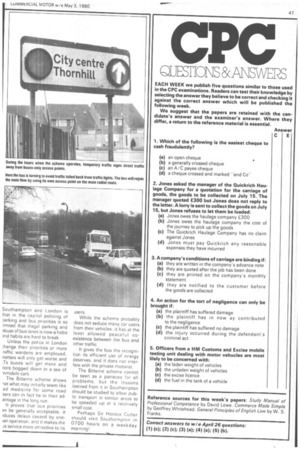Let's get our priorities right
Page 48

Page 49

If you've noticed an error in this article please click here to report it so we can fix it.
London bus lanes don't seem to work but this is by no means the case everywhere. Take So ampton, for instance. Noel Millier reports
AS FAR AS Londonis concerned, bus lanes don't seem to work there as they are widely abused. Motorists blatantly ignore bus lanes and parking restrictions — very possibly due to a combination of the volume of traffic on the roads and bigcity impatience — and this is -reflected not only in lost bus miles but also increased congestion. The motorist is often his own worst enemy.
Sir Horace Cutler, Leader of the Greater London Council, doubts if there is a definitive solution to congestion, but there are complete bus priority schemes operating in Britain that help not only buses but all traffic.
In 1973, after a great deal of controversy and public uproar, a bus priority scheme was introduced to help buses get into .Southampton more smoothly from the suburb of Bitterne.
The scheme involved bus lanes, bus entry points, and bus priority turns, and seven years 'later the Bitterne traffic scheme is still working. Bus journey times have been reduced and the decline of bus passengers has been halted.
I recently visited Southampton and found that by a combination of a sensible regard for traffic regulations by motorists and considerate driving by bus crews, the Bitterne traffic scheme's effects are as beneficial now as they were when the plan was first introduced.
In fact the scheme has become so much a part of everyday life that the only time it is noticed these days is when it breaks down and everybody, whether motorist or bus passenger, is late for work.
The Bitterne scheme applies to bus routes coming into Southampton from its eastern suburbs and it uses an advanced traffic control system which reduces green time at certain traffic lights, illuminates noright turn signs during peak hours, and generally gives buses separate access points to the main radial route into town.
Inductive loop detectors in the road services are used to calculate the length of traffic queues and the extent of traffic volume and they adjust green time on traffic lights accordingly.
By these mean's the Bitterne buses can get through the morning peak traffic a lot faster. So they use less fuel and more passengers use the buses.
The scheme may be complicated but it is reliable and economic. In real terms this means that more passengers use the buses.
According to police there has been no increase in road accidents caused by the segregation of buses from general traffic.
In total, eight queue detector loops, 14 traffic light installations, and ten prohibited manoeuvres (no right turn except buses) are linked by the scheme which controls traffic on the 5.5km of the A3024 from Bitterne to the centre of Southampton.
The scheme only operates from 7am to 9 30pm, but most motorists now regard bus lanes as being in force •permanently and still keep clear of them.
A major difference between
Southampton and London is that in the capital policing of parking and bus priorities is so imited that illegal parking and 3buse of bus lanes is now a habit Ind habits are hard to break.
Unless the police in London ;hange their priorities or more raffic wardens are employed, natters will only get worse and .Ts buses will get more and nore bogged down in a sea of -nmobile cars.
The Bitterne scheme shows at what may initially seem like ad medicine for some road sers can in fact be to their adantage in the long run.
It proves that bus priorities 3n be generally acceptable, it iduces delays caused by oneIan operation, and it makes the is service more attractive to its users.
While the scheme probably does not seduce many car users from their vehicles, it has at the least allowed peaceful coexistence between the bus and other traffic.
It gives the bus the recognition its efficient use of energy deserves, and it does not interfere with the private motorist.
The Bitterne scheme cannot be seen as a panacea for all problems, but the lessons learned from it in Southampton should be studied to allow public transport in similar areas to be speeded up at a relatively small cost.
Perhaps Sir Horace Cutler should visit Southampton in 0700 hours on a weekday morning!












































































































